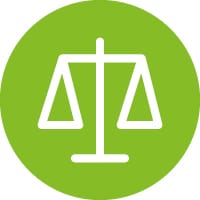Preparing for the loss of an owner has been saved

Perspectives
Preparing for the loss of an owner
Estate planning and legacy assessments for family business
Like the artist whose work outlives them, maybe you’d like your family business to last generations. Securing your legacy begins by asking, "does our family have an estate plan?" In this installment of our eight-part series, "Pivotal moments for family enterprises," we'll explore the value of both estate plans and legacy assessments and explain how to navigate the process to help shape the future of your creation.
At some point in the evolution of every family business, its founder and/or present leader is going to pass on. Even when it happens unexpectedly, the consequences don’t need to come as a complete surprise. Proper planning through a legacy assessment can help position and prepare the family and/or the associated business for continuity and provide a clear understanding of the founder’s or leader’s wishes. Many family business owners may think they’re covered by an estate plan, but an “estate plan” is generally a legal document covering the disposition of the estate assets. While important, it’s just a starting point for navigating the complicated issues associated with the transfer of assets and the payment of transfer taxes.
A legacy assessment goes far beyond that—helping the family and the business understand the ripple effects from a family leader’s passing, including potential liquidity gaps for covering estate taxes, who will ultimately control the family business, unintended repercussions of charitable gifts, potential conflicts among beneficiaries, and other matters related to ensuring the family’s business stability and financial strength. Legacy assessments can provide a more holistic view and empower families and their businesses to make decisions while there is still time to adjust and evolve. After all, an owner’s perspective on their business and who they want to take over often changes over time. It’s important that assessments are regularly reviewed and tested to make sure they remain aligned with the owner’s present goals and objectives.

Preventing the preventable
There is plenty of evidence that family businesses could do a better job preparing for future succession. A pulse survey MLR Media recently conducted of private company leaders—many of which are family-run—found that 52% of respondents have no formal board process for succession planning, and only 30% review their succession plans annually.
The implications for these oversights can be severe. Real-life examples illustrate the costs when estate plans go awry. A child is “disinherited by accident” because their estate tax liability outweighed the value of the business they assumed. A family business is gutted by executive departures after it was left to a charitable organization with no intention of retaining it. The administration of a large estate is left to siblings with no history of being able to cooperate. The list goes on.
Legacy assessments seek to attain a full picture of the implications when a key family member passes away or steps away from their responsibilities. These evaluations can put the family business and, most importantly, the family, in a significantly better position to address the potential implications of losing a family member. Through a broad-based, thoughtful, and organized process, a legacy assessment could help identify gaps in knowledge, documentation, and other critical areas that could affect business continuity and the family’s financial strength. It can eliminate the need to make important decisions quickly during a mournful time and provide confidence that a well-considered plan is in place.

For anyone who may be affected
In many high-net-worth families, the senior generation may own a large share of the assets and exert significant control over the family enterprise, leaving them concerned about what will happen when they pass on.
But there are scores of other parties who may be focused on sustaining the family legacy—from family office leaders who are focused on potential legacy issues, to non-family C-suite leaders who need to know the company—and their jobs—will survive the loss of a key family leader.
Where to start
- 90-day drill: This process involves identifying the necessary financial, accounting, legal, regulatory, and administrative action items that need to be addressed in the period immediately following the individual’s passing. Some may benefit from going through the process of preparing the federal estate tax form, or at least understanding where all the information is for doing so. “It’s a dress rehearsal for the real thing,” says Courtney Reitman-Deinlein, managing director at Deloitte Tax LLP. “No matter how well-prepared someone thinks they are, there is often something missing, and all the related information required may be easier to locate when the individual is still alive.”
- Cash flow and other financial projections: This part of the assessment involves reviewing all the assets and estate planning documents to understand the immediate financial implications of the individual’s death. It quantifies the projected expenses, liabilities, and potential taxes owed, and then identifies sources of liquidity to pay them. It helps survivors understand their short-term cash requirements and whether their access to cash will be restricted or delayed in any way. “A creditor could be knocking on your door in short order,” says Craig Janes, partner at Deloitte Tax LLP. “You can get yourself into a lot of problems if you don’t have access to cash.”
- Asset disposition analysis: A legacy assessment helps tell the story of what is going to happen to the family wealth, how each generation will be affected, and who will oversee each asset. In addition to trusts, this step considers retirement plans, insurance policies, and equity ownership agreements that may come into play. It provides an analysis of issues related to the disposition of specific assets—such as large, concentrated equity positions, unique real estate holdings, and other hard to value and illiquid assets—and examines the likely financial implications of their disposition or gifting. “A trust agreement is a story, but it’s a long one, and heirs don’t often understand what’s really going to happen to the assets,” says Laura Hinson, managing director at Deloitte Tax LLP. “The process helps bring all the pieces of the narrative together so that family members can understand the path forward.”
- Leader engagement: Along with understanding documentation needs and gaps, financial projections, and asset disposition options, perhaps the most important value in a legacy assessment is the participation of the founder or leader. Understanding their expectations and desires can cement their legacy, preserve family harmony, and eliminate potential guesswork or conflict after they’ve passed.

Time to course correct
Importantly, a legacy assessment generates concrete steps the family or business can take to address the issues identified during the fact-finding and projection phases of the process.
“Phase two of the assessment is about identifying certain aspects of the plan that need improving or digging a bit further to better understand what problems might arise so the family or the business can implement the right solutions,” says Janes.
In the case of a child “disinherited” by estate tax liability, a legacy assessment can help avoid such outcomes by highlighting the need to restructure the asset distribution to have all siblings pay their fair share of taxes.
To help keep family businesses from being affected by sudden executive departures, leaders can implement certain financial incentives intended to encourage employees to remain with the company for a stipulated period (e.g., “golden handcuffs”).
Conflicts among family trustees, another common issues that arises, can be avoided by confining the administration of the estate to family members with a history of objectivity and collaboration.
In one final example, family businesses can utilize existing income tax attributes, such as net operating losses, to prevent the loss of tax benefits tied to the business owner upon their passing.

Accounting for life
While a legacy assessment can be conducted at any time, it can be particularly valuable when the family has recently experienced a big life event, such as a marriage or birth, or a family member or the business is facing cash flow challenges. Changes in tax laws can also serve as a trigger for legacy assessments.
“Life happens, and big changes or changes of heart can upset even the most well-laid plans,” Hinson says. Hinson and her colleagues recommend families revisit their legacy plan at least every three to five years to ensure it is up to date and accounts for these life-changing, and potentially legacy-changing, developments.
Legacy assessment questions for consideration
Here’s a list of questions to ask yourself if you’re considering the need for a legacy assessment now or in the near future:
| Does our family have an estate plan, and do we understand its full consequences? |
Have we mapped out our cash flow obligations stemming from a death in the family and what available sources of cash will be used to pay them? |
||
 |
Will we need to dispose of any family assets to cover the estate’s liabilities? | Will the obligation to pay estate taxes affect the family enterprise’s ability to continue growing? | |
 |
Are there any potential intra-family conflicts that could arise from trustee and other estate leadership appointments? |  |
If our family has charitable intentions for the estate, do we know how they will affect the ability to keep the family enterprise operating? |
Next up in our series: “Leadership transition and the next generation” will discuss how to set up successors—and the business—for success before a transition takes place.
Recommendations
Assessing Capital Needs
New funding options can help family businesses grow
The art of family business technology
Modernizing your technology infrastructure for growth



